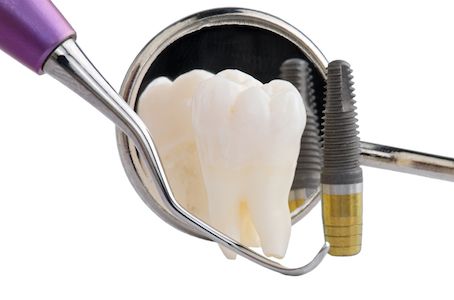Patients usually associate the term “false teeth” with dentures, a dentition replacement method that often has negative connotations. The technology behind repairing a smile with missing teeth is more involved than simply popping in some imitation pearly whites. Using dental implants, patients have access to a treatment that will not only renew their smile but also offer more stable and long-lasting new teeth at the same time.
 Before deciding on any treatment plan, Smile Design Dental wants to make sure you understand a few important facts about dental implants. Our staff is ready to help clients in the Broward County area. To schedule a consultation, don’t hesitate to call us today!
Before deciding on any treatment plan, Smile Design Dental wants to make sure you understand a few important facts about dental implants. Our staff is ready to help clients in the Broward County area. To schedule a consultation, don’t hesitate to call us today!
1. Dental Implants are Effective
People have been looking for ways to take care of missing teeth for thousands of years. From Mayans hammering shells into their gums to Egyptians wedging copper posts to fill gaps, many methods have not always been as practical or comfortable as the treatments used today. Replacing a lost tooth involves mimicking the way it was seated in the first place, which is why dental implants are so successful.
Titanium is one of the strongest and most corrosion-resistant metals on the planet, and it also reacts very well with bone. This makes the metal an excellent option for strong and durable surgical implants, especially in areas that require high bone density like the jaw. Fashioned into screw-like posts, the titanium implant serves as the “root” for your new tooth.
Anyone who has had a visit from the Tooth Fairy knows that teeth are anchored into the jaw with roots. A titanium implant will fill that space, creating a new platform that serves to mount a crown, bridgework, or even dentures! Unlike other treatments, this method locks false teeth into place and mimics the same look and feel as natural ones.
2. The Procedure is Uncomplicated
While some may find the decision to get dental implants difficult, most will find the actual procedure quite the opposite. While there are several steps to the treatment plan, it is a straightforward process that is easy to understand and endure.
- Initial Preparations: Because dental implants are meant to look and feel like natural teeth, your dentist needs to make an imprint of your mouth. This will help an off-site lab to make a false tooth that fits perfectly. Additionally, x-rays are necessary for the doctor to inspect the jaw and check bone density and see if implantation is even possible.
- Implant Installation: If the jaw isn’t strong enough for the procedure, a bone graft will help to strengthen the area but it needs time to heal. Unless you need a bone graft, the implant is inserted on your next visit via the gumline or directly into the jaw. The area is then sealed up and allowed to heal so osseointegration can take place. This occurs when the bone begins to grow around the implant, securing it in place, a process that can take from 3 to 9 months.
- Abutment Placement: The dental implant itself is only the anchor for the dental crown to sit on. An abutment is a device that actually connects the false tooth to the root. While it is sometimes installed at the same time as the implant, there are times that it is safer to wait until an implant is more secure. A temporary crown may be attached at this point to allow you to become comfortable while you wait while the permanent crown is being manufactured.
- Attaching the Crown: When the false tooth is finished, your dentist will call you in to have the crown attached to your implant. Bridges and dentures can be removable for easier cleaning, while permanent false teeth can be cared for just like your natural ones!
Once the procedure is complete, you/ll be able to chew, talk and smile just as you would with your original dentition.
3. Low Discomfort While Healing
When searching for important facts about dental implants, many patients are very concerned about how painful the process might be. The actual procedure will be as painless as any dentist visit as your doctor will numb the affected area. In addition, they can recommend other anesthesia you may need to keep you comfortable.
Many patients report that there is some discomfort after the procedure, akin to having a tooth pulled. This can last for up to 10 days and is easily managed by over-the-counter pain relievers. Continuing to brush, being gentle around the affected area, will help keep the chance of infection down, and a saltwater rinse kills germs and eases pain as well.
Some patients have discomfort that shouldn’t last past weeks after the permanent crown has been installed. Like before, this can be managed with standard pain medicine. After you’ve healed there should be no pain at all when using your new implants, allowing you to get back to your routine quickly, with a fresh, new smile to boot!

4. Most Patients are Good Candidates
There are a variety of reasons why someone would want dental implants, but not everyone is able to go through the procedure. Patients missing a single tooth or many can get a lot out of the treatment, especially if they meet much of the following criteria:
- In good overall (and oral) health
- Good jawbone density (can be mitigated with grafting)
- No health problems that might impede recovery
- Time to follow the month-long treatment plan
- Jawbone must be fully developed
- No tobacco use
Maintaining good oral hygiene is essential to successful dental implant surgery. Smoking or using chewing tobacco will greatly hinder the healing process and should consider quitting before electing to go through the procedure. Also, those with low bone density or damaged jaws might find their mouths unsuitable for this procedure.
5. Dental Implants Act Like Natural Teeth
One of the benefits of dental implants is their stability. Unlike dentures that can slip and become uncomfortable as the day goes on, implants remain seated in place. This makes speech easier, and many patients see a dramatic improvement after their treatment. Titanium is strong and durable, and the crown can be made of a host of different materials that make them last a long while.
Oral hygiene with dental implants is just like taking care of your natural teeth, too. Regular brushing and flossing will remove plaque buildup and prevent discoloring, though your new crowns won’t be subjected to tooth decay. With regular 6-month dental visits, your crowns may last decades while the implant can endure a lifetime.
As far as looks go, few people can quickly identify false teeth when compared to natural dentition. Color matching ceramic crowns will help ensure they blend in with your teeth, and because they are expertly crafted few people will be able to spot the fake. Some patients have issues with receding gums which may expose some of the crown’s metallic base. While this can create a dark underscore along the gum line, it can be avoided with proper care.
6. A Lifelong Investment
Dental implants might appear as the more expensive option for tooth replacement, especially when some insurance companies don’t cover the costs. However, alternatives such as dentures and bridges need constant upkeep and care, usually only lasting 5 to 10 years. Continued maintenance adds up, and for many patients, the advantages far outstrip the initial cost.
After an initial consultation, your dentist will be able to offer a better idea of the total procedure’s cost. There are a number of factors that determine the final valuation for dental implant treatment. Some of these include:
- Number of teeth to be removed and/or replaced
- How many crowns or bridges are needed
- Necessity of bone grafts
- Material of crowns used
- Pre- and post-operative care
 Titanium implants promote osseointegration, meaning they stimulate bone growth. This makes the treatment much more viable in the long run since it helps your jaw keep its shape. Dentures actually inhibit the strengthening of your jaw and may even contribute to bone loss. A deteriorating jaw will eventually change the shape of your face and can lead to a host of other health problems as well.
Titanium implants promote osseointegration, meaning they stimulate bone growth. This makes the treatment much more viable in the long run since it helps your jaw keep its shape. Dentures actually inhibit the strengthening of your jaw and may even contribute to bone loss. A deteriorating jaw will eventually change the shape of your face and can lead to a host of other health problems as well.
Conversely, dental implants not only help maintain bone density but also contribute to keeping your original teeth. Gaps caused by tooth loss will adversely affect the rest of your dentition, harming bite force and pushing the rest of your teeth in unnatural positions. Patients that elect for this treatment will find those gaps disappear, leaving them with a healthy, wholesome, and beautiful smile!
Any surgery should not be entered into lightly, and the implant procedure is no exception. At Smile Design Dental, we want all of our patients to understand the benefits and drawbacks of every treatment plan. Our clinicians are on hand to help you make the best decisions regarding your oral health. Call our offices to learn more about how dental implants can change your life.




